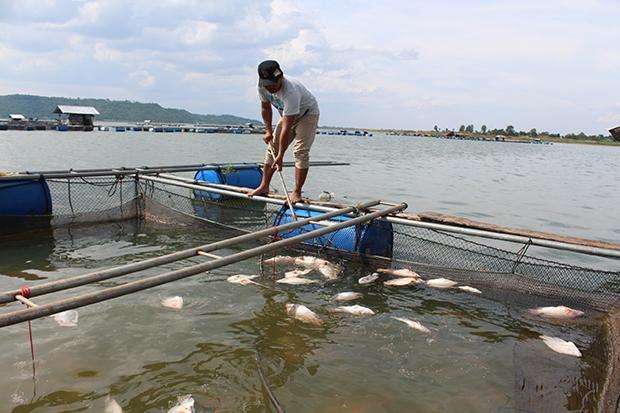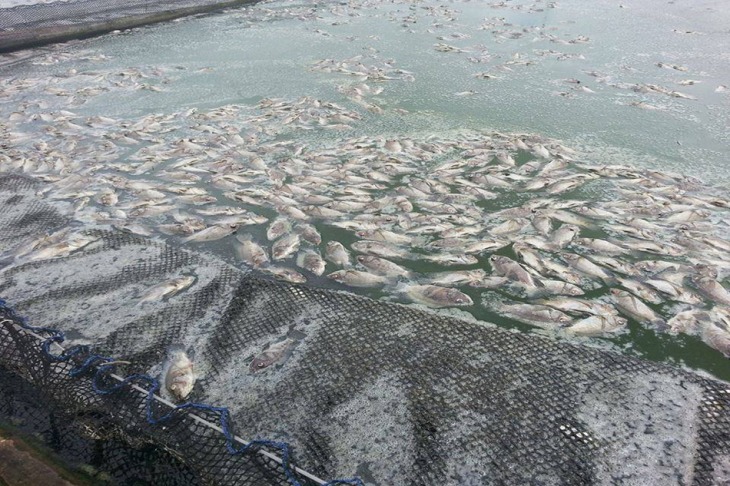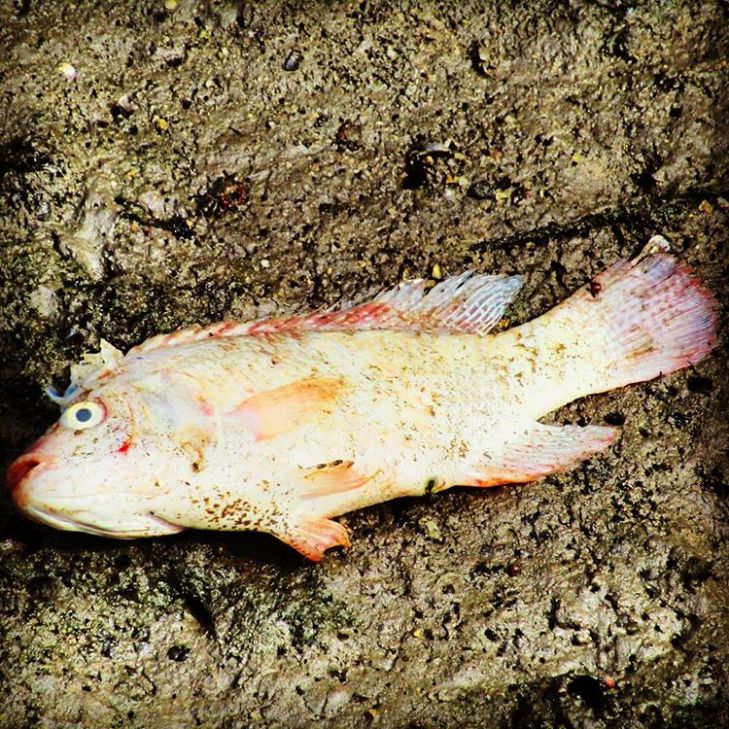This carcass is too decomposed to be conclusively identified; there are several species of Cichlids that can be found in coastal waters around Kranji, such as Tilapia (Oreochromis spp.), Green Chromide (Etroplus suratensis), and Mayan Cichlid (Mayaheros urophthalmus). It’s also possible that the carcass may have been flushed out from the nearby Kranji Reservoir, which harbours other Cichlid species that are found in freshwater, such as Eartheater (Geophagus altifrons).
Tag / Cichliformes
Daily Decay (21st February 2018)
Red Tilapia are hybrids, typically between Nile Tilapia (Oreochromis niloticus) and Mozambique Tilapia (Oreochromis mossambicus), although other species have also been involved. They are commonly raised in fish farms for human consumption, and escapees are regularly seen in some parts of Sungei Buloh Wetland Reserve.
Daily Decay (4th February 2018)
Daily Decay (4th February 2018): Red Tilapia (Oreochromis sp.) @ Sungei Buloh Wetland Reserve
Red Tilapia are mostly hybrids, typically between Nile Tilapia (Oreochromis niloticus) and Mozambique Tilapia (Oreochromis mossambicus), although some Red Tilapia strains have involved crossing other species such as Blue Tilapia (Oreochromis aureus) and Wami Tilapia (Oreochromis urolepis hornorum). There are also red-coloured mutants of Nile and Mozambique Tilapia. Red Tilapia are commonly raised in fish farms for human consumption, and escapees are regularly seen in some parts of Sungei Buloh Wetland Reserve.
Orinoco Peacock Bass
Orinoco Peacock Bass (Cichla orinocensis)
Coney Island (Pulau Serangoon), 25th April 2017
This Orinoco Peacock Bass was found dead along the shore of Coney Island. Being a freshwater fish, its presence along the coast was unusual. It is possible that this fish was living in the nearby Serangoon Reservoir, but was unfortunately washed into the sea when the tidal gates were opened. Unable to cope with marine conditions, it would have been killed by prolonged exposure to saltwater, and then subsequently washed up on the beach with the tides.
- The Biodiversity of Singapore
- Ecology Asia
- HandlineFishing.com
- An Annotated Checklist of the Non-Native Freshwater Fish Species in the Reservoirs of Singapore
- Urban stormwater ponds in Singapore: potential pathways for spread of alien freshwater fishes
- Multiple records of aquatic alien and invasive species in diets of native predators in Singapore
- Acute Angling
- FishBase
- The Cichlidroom Companion
- A review of the South American cichlid genus Cichla, with descriptions of nine new species (Teleostei: Cichlidae)
- Systematics, biogeography, and evolution of the Neotropical Peacock Basses Cichla (Perciformes: Cichlidae)
Daily Decay (19th January 2018)
Daily Decay (19th January 2018): Green Chromide (Etroplus suratensis) @ Coney Island (Pulau Serangoon)
Malaysia: Caged fish breeders suffer major losses due to flood
13th January 2018;
The flood that hit the district early this month had not only caused damage to public and private properties, but also caused major losses to caged fish breeders here as they were left with thousands of dead fish.
Most of the breeders attributed the death of their fish to several reasons, including the strong river current on Jan 1 and 2 when the water level of Sungai Pahang began to rise.
Khaidir Ahmad, 55, from Kampung Tebing Tinggi, Lebak here, when contacted today said he suffered losses of more than RM33,000 after over 5,000 patin (Iridescent Shark Catfish) (Pangasianodon hypophthalmus) and Tilapia (Oreochromis spp.), as well as 300 kerai (Lemon-fin Barb) (Hypsibarbus wetmorei) fish, in his cages died during the flood.
He said the strong river current had caused the fish to suffer wounds as they were cornered and squeezed to the cage.
“The fish were also believed to have died due to the high turbidity level of the river which caused the fish gills to be covered with mud and deprived them of oxygen,” he said, adding that bacterial infection in the eyes and scales of the fish due to the deterioration in the water quality of Sungai Pahang was also believed to be the cause of death of the fish.
Meanwhile, Temerloh Fisheries Officer Shahidan Roslan said the Fisheries Department had taken samples from the live fish in order to determine the cause of death of thousands of caged fish of several breeders in the district.
He said the department had also informed the state Fisheries Department Bio-security Division, immediately after receiving a report on the incident.
Shahidan said initial inspection found that the death of patin and Tilapia fish was probably due to the strong river water pressure during the recent flood.
“The investigation revealed that most of the dead fish were found in the front area of the cage which might have received the high impact of the strong current,” he said.
Source: The Sun Daily
Philippines: Virus strikes Bulacan pond, kills 101,383 Tilapia – report
By Jasper Y. Arcalas, 7th December 2017;
The lethal Tilapia Lake Virus (TiLV) has arrived in the Philippines, killing 101,383 Tilapia (likely Nile Tilapia) (Oreochromis niloticus) in a lone Bulacan-based pond in June, the Department of Agriculture (DA) said.
In a notification submitted to the World Organisation for Animal Health (OIE), Agriculture Assistant Secretary for Livestock Enrico P. Garzon said TiLV killed 101,363 Tilapia out of the 300,000 susceptible population in a Bulacan-based pond, representing a 33.78-percent mortality rate.
Garzon added the outbreak was confirmed last June 29 and has already been resolved by the DA on September 15.
“An unexplained daily mortality of Tilapia fingerlings was observed in the nursery pond of a private farm after stocking on May 16, 2017. Elevated mortality after 15 days reached approximately 25 percent. Affected fish showed distended abdomen and bulging of the eyes,” he said in the notification dated November 23.
Garzon said on May 31, the DA collected samples from the affected farm and were submitted to the Fisheries Biotechnology Center (FBC) in Muñoz, Nueva Ecija.
“Semi-nested RT-PCR exhibited positive results using reported Tilapia Lake Virus [TiLV] primers. Other samples submitted to National Fisheries Laboratory- Fish Health of the Bureau of Fisheries and Aquatic Resources also showed positive results by insulated isothermal PCR [iiPCR],” he said.
The DA official added the laboratory results indicated that the “amplified 3 segment of the viral ENE [expression and nuclear retention element] has 94 to 95 percent nucleotide similarity to Israel TiLV strain.”
Garzon said the movement of fingerlings from the affected pond has been restricted and monitored. He added that the results of the last two samplings showed negative for TiLV.
On May 26 the Food and Agriculture Organization (FAO) of the United Nations warned countries of TiLV as it is considered a “lethal threat” to food security.
“The outbreak should be treated with concern and countries importing Tilapia should take appropriate risk-management measures—intensifying diagnostics testing, enforcing health certificates, deploying quarantine measures and developing contingency plans,” the FAO said.
“Tilapia-producing countries need to be vigilant, and should follow aquatic animal-health code protocols of the World Organisation for Animal Health when trading Tilapia. They should initiate an active surveillance program to determine the presence or absence of TiLV, the geographic extent of the infection and identify risk factors that may help contain it,” the FAO added.
The FAO said the TiLV poses no public health concern, but could decimate infected populations. The TiLV has been reported in at least five countries in three continents: Colombia, Ecuador, Egypt, Israel and Thailand, according to the FAO.
“Tilapia are the second most important aquaculture species in volume terms, providing food, jobs and domestic and export earnings for millions of people, including many smallholders,” it said.
“In 2015 world Tilapia production, from both aquaculture and capture, amounted to 6.4 million tons, with an estimated value of $9.8 billion, and worldwide trade was valued at $1.8 billion,” the FAO added.
Source: Business Mirror
Philippines: Virus strikes Bulacan pond, kills 101,383 Tilapia – report

Daily chore: Farmer Sompong Wongbao scoops dead fish from the water at Lamsae Dam reservoir in Nakhon Ratchasima.
Photo: Prasit Tangprasert
Thailand: Farmed fish dying from heat at Lamsae Dam
By Prasit Tangprasert, 19th April 2017;Fish raised in hinged floating baskets in the Lamsae Dam lake in Khon Buri district have been dying by the hundreds as daytime temperatures rise to nearly 40°C.
Fish farmers said the deaths were probably caused by a drop in the oxygen in the water under the scorching sun.
Sompong Wongbao, 34, said that for the last three days his regular chore had been to scoop out dead and dying fish. He gave them to his neighbours, who would dry or pickle them.
He said the dead fish showed no traces of disease and he believed they simply died from the heat.
Mr Sompong said he had lost about 7,000 baht in income over the past three days.
Other fish farmers at Lamsae Dam were facing the same problem, he said.
Source: Bangkok Post

Photo: Francis Canlas
Philippines: PHP126-M Tilapia destroyed in Lake Sebu fish kill; state of calamity declared
By Allen Estabillo, 2017;Officials of Lake Sebu town in South Cotabato have placed the entire area under the state of calamity due to a recent massive fish kill that destroyed around P126 million worth of Tilapia (Oreochromis niloticus).
Roberto Bagong, action officer of the Lake Sebu Municipal Disaster Risk Reduction and Management Office, said Thursday the municipal council issued the calamity declaration in a session on Wednesday.
He said the move was based on a recommendation from their office and the MDRRM Council headed by Mayor Antonio Fungan.
But he said the council has set conditions that they need to accomplish in line with the declaration, among them the immediate submission of some documentary requirements.
Three barangays – Poblacion, Takonel and Bacdulong – were earlier placed under the state of calamity due to the impact of the fish kill from January 27 to February 4.
The fish kill, which is considered the worst in Lake Sebu so far, destroyed around 1.4 million tonnes of Tilapia from 4,944 fish cages owned by 464 operators.
Bagong said that based on their latest assessment, the estimated damage value has reached over P126 million. The average farm-gate price for Tilapia in Lake Sebu is at P90 per kilo.
As next move following the calamity declaration, the official said they will convene the town’s fish cage operators and other stakeholders on Monday next week for a dialogue and consultation.
He said they will introduce to local fishing stakeholders various recommendations made by the Bureau of Fisheries and Aquatic Resources (BFAR) and the provincial government of South Cotabato to help address the recurrent fish kills at the lake.
These include the enforcement of the 10 percent limit of the lake’s area for aquaculture development as set in Republic Act 8850 or the Philippine Fishery Code of 1998.
Around 20 percent of the 354-hectare lake are presently occupied by fish cages or way higher than its carrying capacity.
“They also recommended the setting of a regular closed season for fishing and a moratorium of two to five years for fish cage operations,” he said.
On the part of the municipal government, he said they will push for the immediate cleanup of Water Hyacinths (Eichhornia crassipes) or Water Lilies (Nymphaea sp.) in parts of the 354-hectare lake.
Bagong said they will also forge memorandum of agreements with fish cage operators for the conduct of regular cleanup in areas that they occupy.
He said they will tap the participation of the barangays in the cleanup activities to ensure that they would be sustained.
Experts noted that the overcrowding of fish cages at the lake, the proliferation of Water Hyacinths and the use of commercial feeds by operators have caused its waters to deteriorate, triggering fish kills.
They trigger the occurrence of “kamahong,” a phenomenon that is mainly caused by the sudden rise in the water’s temperature.
“Kamahong,” which usually occurs during the rainy season, triggers the rise of sulfuric acid in the lake’s waters that eventually cause the massive fish kill.
BFAR earlier said results of its water sampling on the lake and other physio-chemical parameters showed that Lake Sebu’s waters are “dying.”
Last year, the municipal government of Lake Sebu recorded at least eight fish kill incidents that destroyed around P1.4 million worth of Tilapia. The last major fish kill in the area was in 2014.
Source: Philippine News Agency

Around 1,383 tons of Tilapia have died in the fish kill in Lake Sebu, South Cotabato.
Photo: Francis Canlas
Philippines: Fish kill damage reaches P100-M in South Cotabato
By Francis Canlas, 2nd February 2017;The fish kill in Lake Sebu, South Cotabato, has already cost fish farmers over P100 million in losses, authorities said Wednesday.
According to the town’s lake warden, Rudy Muyco, a total of 1,383 tons of Tilapia (Oreochromis niloticus) have died in the fish kill since Friday.
Three barangays have declared a state of calamity because of the fish kill. Vice Mayor Floro Gandam said the Sangguniang Bayan will also hold a special session to place the town under a state of calamity.
Fish dealers have warned that there’s a looming shortage of Tilapia in the area because of the fish kill.
“Sa ngayon wala pa kaming mapagkunan. Kasi yung kapatid ko doon kumukuha sa taas sa Lake Sebu,” said Irene Joy Juanico, a fish dealer in the town of Surallah.
(Right now, we can’t get any supplies. My sibling usually gets supplies from up there in Lake Sebu.)
Juanico said she usually sells more than 20 kilos of Tilapia a day. But right now, there is none to sell.
Muyco said they continue to collect dead fish from the lake for disposal. He added that they are now working to minimize the foul smell of decomposing fish in the area, as this could affect tourism in Lake Sebu.
Local officials said they will use calamity funds to buy fingerlings and fish feed, which will be distributed to the affected operators.
They estimate it will take six to eight months before fish farmers recover from losses incurred in the fish kill.
Source: ABS-CBN News
![30590384_172348133347146_95558194792759296_n[1]](https://mondaymorgue.wordpress.com/wp-content/uploads/2018/04/30590384_172348133347146_95558194792759296_n1.jpg?w=730)
![[1]](https://mondaymorgue.wordpress.com/wp-content/uploads/2018/02/27878915_2009762602644495_1406644335386034176_n1.jpg?w=730)

